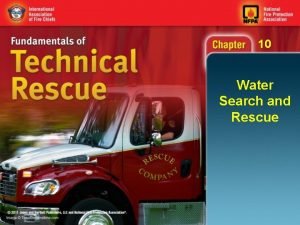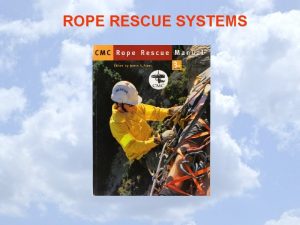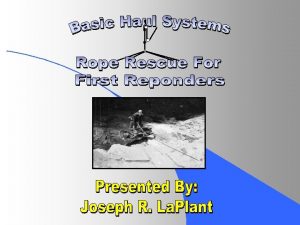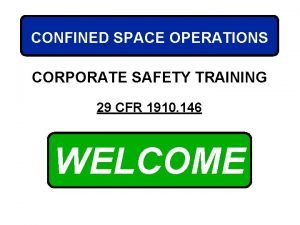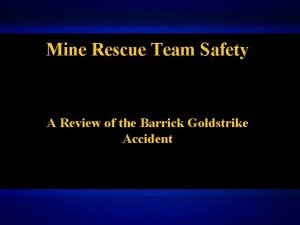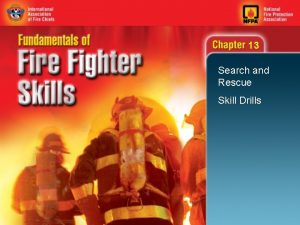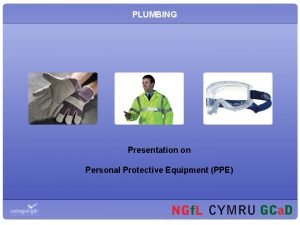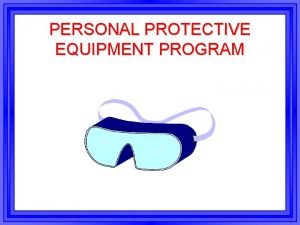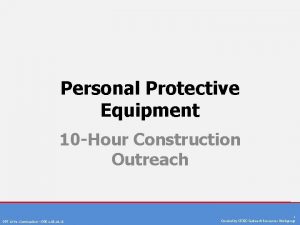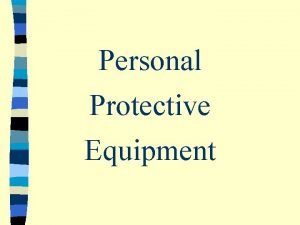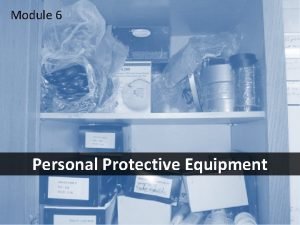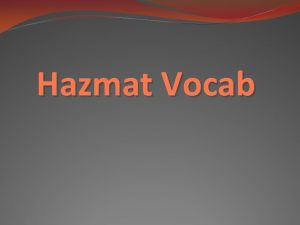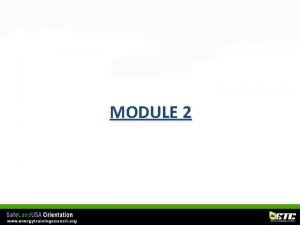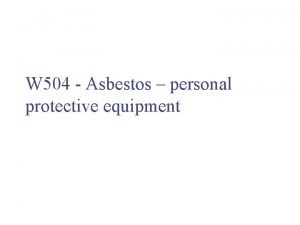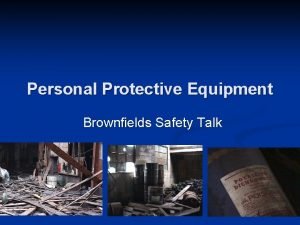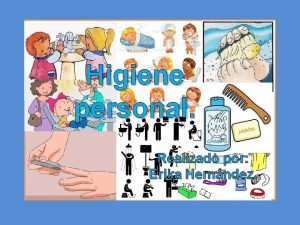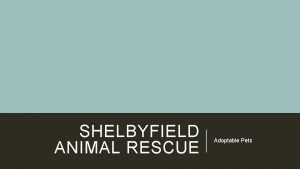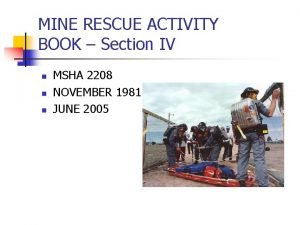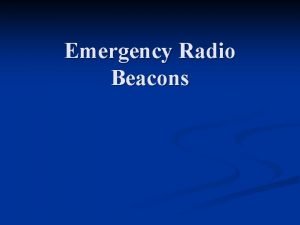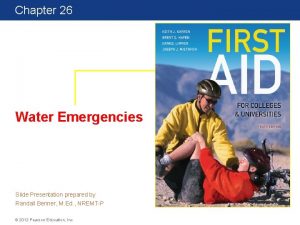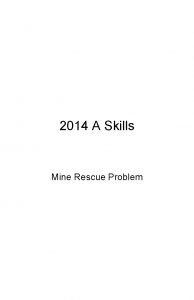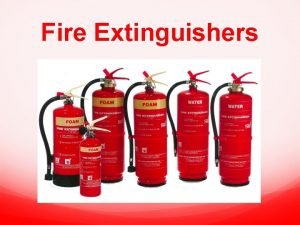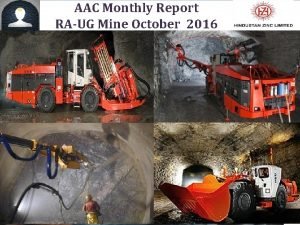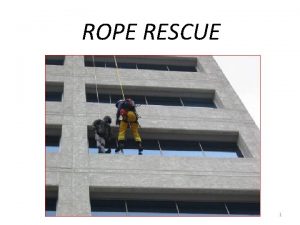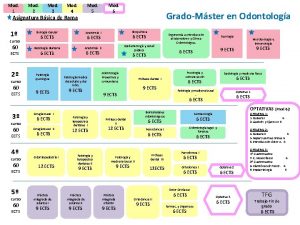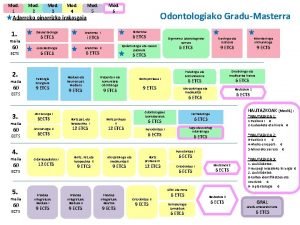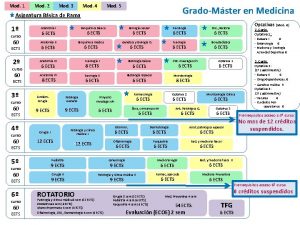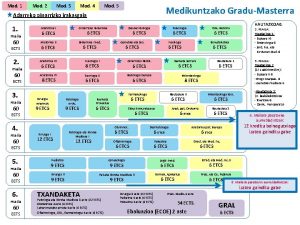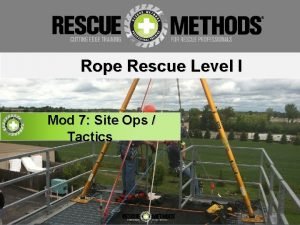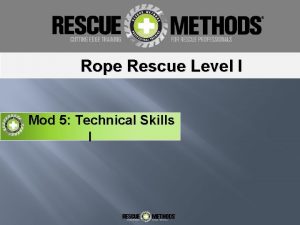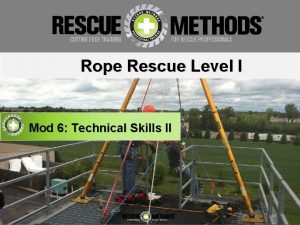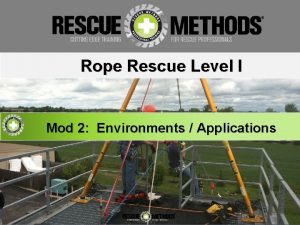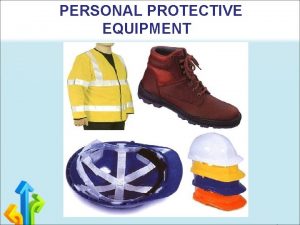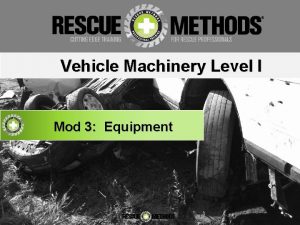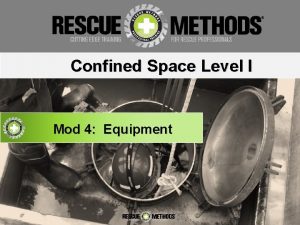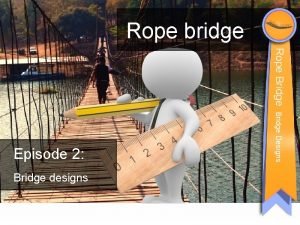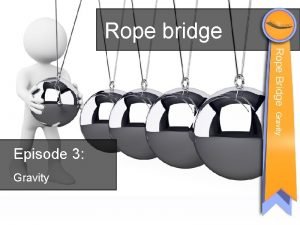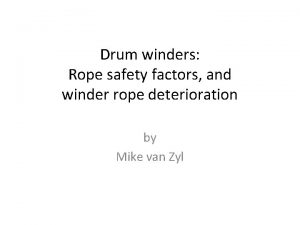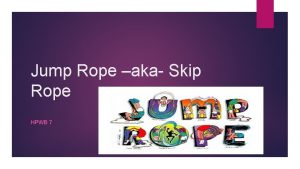Rope Rescue Level I Mod 4 Equipment PERSONAL































































- Slides: 63

Rope Rescue Level I Mod 4: Equipment

PERSONAL EQUIPMENT AND PROTECTION �Headgear – NFPA, UIAA, CE �Footwear �Gloves �Harnesses - NFPA �Headlamp - Intrinsically Safe (consideration) �Cutting Tool* �Safety Glasses

Personal Protection and Equipment �Headgear �Three point suspension �High adjustability �Ventilation properties �Approved protective shell �Lightweight �Narrow profile �Lighting �Lightweight �Variable settings

Personal Protection and Equipment �Gloves �Provide dexterity �Weather and environment appropriate �Reinforced to Protect palm and fingers

Personal Protection and Equipment �Footwear �Provide ankle support �Weather and environment appropriate �Non slip sole with aggressive tread

HARNESSES � General harness types: � Commercial or manufactured � Improvised � Webbing or Rope �Choose a harness for: �Comfort �Safety �Security �Function

NFPA 1983 Harness Classes �Class I – Seat Harness � Design load of 300 lb (1. 33 Kn) � Designed for emergency escape �Features � Comprised of lesser dimension products which impact comfort and security � NOT INTEDED FOR RESCUE APPLICATIONS

NFPA 1983 Harness Classes • Class II – Seat Harness Design load of 600 lb (2. 67 k. N) • Designed for rescue • Features • • • Limited attachment points Secure if properly fitted Rapid donning Provides a high degree of maneuverability

NFPA 1983 Harness Classes �Class III – Full Body Harness �Design load of 600 lb (2. 67 Kn) �Designed for rescue �Features � Multiple attachment points � High level of comfort and security � May limit ability to invert depending on attachment point � May be time consuming to don

Class III Combination Class II

Rope �Classification Of Rope Stretch Per CI 1801 -91 �Three classifications for rope � Static � Low Stretch � High Stretch or Dynamic �Each classification is based upon the relationship between elongation and MBS. �The following chart depicts acceptable elongation ratios within each classification when a load equal to 10% of the MBS is applied

Rope Stretch Classification Static = Less than 6% stretch at 10% MBS Elongation 0, 7 0, 6 0, 5 Low Stretch = 6 – 10% stretch at 10% MBS High Stretch = Greater than 10%, typically 40 – 60% stretch at 10% MBS 0, 4 0, 3 0, 2 0, 1 0 10% MBS Static Low High

Rope Design Fibers Used To Make Rope � Natural Fibers � Sisal, Hemp And Manila Qualities � � � � Condemned for rescue use per NFPA 1983 Low resistance to abrasion Limited ability to absorb shock loading Strength degradation Decay Low breaking strength No continuous fibers

Rope Design Fibers Used to Make Rope � Synthetic Fibers � � � Polyolefin (polypropylene or polyethylene) Polyester (Dacron) HMPE ( extended chain high modulus polyethylene) Aramid Fibers Nylon � Qualities � � Do not decay Do not age as quickly as natural fibers Produce more advanced configurations and fiber designs than natural fibers Virgin fibers that can be produced as continuous elements

Fiber Performance Analysis Impact Load Resistance Nylon Melting Point Polyester Aramids Abrasion Resistance HMPE Polyolefins Tensile Strength 0 1 2 3 4 5 6

Rope Design �Special Properties �Polyolefins (Polypropylene) does not absorb water and floats. � Primary application: Water Rescue �HMPE (Spectra) is extremely slippery and does not hold knots well or resist impact loads � Primary application: Climber’s slings and runners

Rope Design �Special Properties �Aramids (Kevlar) is highly susceptible to abrasion and damages easily with sharp bends. Very high heat resistance � Primary application: Search lines �Polyester (Dacron) maintains strength when wet but is not as resistant to impact loads as Nylon. � Primary application: Life Safety (Rescue) �Nylon (Type 6 and Type 6. 6 (Perlon)) may lose 10 – 15% of its strength when wet. � Primary application: Life Safety (Climbing and Rescue)

Rope Design �Blends �Fibers can be combined to achieve optimal rope performance �Predominant blends for life safety will involve nylon and polyester

Rope Design Laid Construction (twisted or hawser laid) �Oldest, most familiar design �Twisting of fibers into yarns, yarns twisted into strands, strands twisted into rope �Tends to untwist when loaded �Susceptible to abrasion Plaited Construction �Bundles of fibers plaited together �Prone to abrasion and “picking” �Tend to be soft and pliable

Rope Design Braided Construction � Solid Braid. �Single weave of three or more fibers �Load supporting fibers vulnerable to destruction � Hollow Braid �Not used for life safety �Sometimes has a filler yarn inside �Essentially a very thick sheath

Rope Design � Double Braid �A solid braid (core) covered by a hollow braid (sheath) � 50% strength in core and sheath �Outer sheath slips on core easily �Easily contaminated �Susceptible to “picking” and abrasion

Rope Design �Kernmantle Construction �Compound German word – kern = core; mantle = sheath �Core fibers covered by woven sheath. � a. Core = 85% to 95% of rope strength � b. Sheath = 5% to 15 % of rope strength �Does not spin or twist when loaded �Sheath protects load carrying fibers �Block Creel construction

Rope Design � Two type of Kernmantle � Dynamic (High Stretch) � � � This rope is designed with a twisted core that mechanically acts as a spring when under a load May stretch as much as 60% before failing Relatively thin sheath Easy to handle and manipulate Due to elasticity it performs poorly in rescue applications Primarily utilized in climbing applications

Rope Design � Two type of Kernmantle � Static (Low Stretch) � � � This rope is designed with a core that has parallel cords to facilitate low stretch when under a load May not stretch more than 20% before failing Relatively thick sheath Better protection of the core and abrasion resistance. Primarily utilized in rescue applications

Rope Design � Rope selection for Rescue Applications � � � Diameters of 3/8”, 7/16”, 1/2” and 5/8” are most common 7/16” – 5/8” is the required diameter for “G” design load per NFPA 1983 Federal Test Method 191 A, Method 6016 insures that rope is in compliance with designated performance standards Color and patterns can be selected to designate purpose and length Dynamic rope should only be considered based on fall factor

Software Accessory Cord � Smaller diameter rope � Sizes from 3 mm to 9 mm � 2 types of cord � Climber’s cord � Rescue cord �Applications �Progress capture devices (7 – 8 mm typically) �Load Release Hitches (10 mm rope preferred)

Software � Webbing � Manufactured from nylon or polyester �Application: Improvised harnesses, lashing, utility � Does not absorb shock loading well � Sized from ½” to 2”

Software � Flat Webbing � Single layer of material � More expensive � Stronger but stiffer �Tubular Webbing �Supple and easier to work with �Edge stitched or shuttle loom construction �Less costly �Holds knots better

Software �Webbing Strength � 1” tubular, nylon (most common) � 4000 lb. T. S � 2” tubular, nylon � 6000 to 8000 lb. T. S � 2” flat, polyester � 6000 lb. T. S � 1” flat, nylon � 6000 lb. T. S � 2” tubular nylon webbing should be the primary choice for improvised harnesses due to comfort and performance

Software Maintenance �Maintain rope logs � Document usage, inspection and maintenance � Logs create a working history of the rope which will help insure safe operations and documentation in case of failure or lack of product performance � Each rope should have a distinguishing identification that correlates to the log. This is usually accomplished by marking the end of the rope and protecting the mark with heat shrink or whip end dip.

Care and Use of Rescue Rope and Related Equipment

Software Maintenance �Avoid exposing rope to: �Harmful Substances �Overloading �Damage From Falling Objects �Heat Fusion �Excessive Knots and Bending (4: 1 / 2: 1 Rule) �Flash Rappels �Abrasion

Software Maintenance �Inspection �Tactile and visual evaluation of software should be conducted before and after each use �Any lack of uniformity in the presentation of the rope or evidence of exposure to the previous list of hazards require the rope or rope section to be removed from service and tagged for retirement �Manufacturer’s recommendations should be followed in regards to rope life span and performance and wear standards

Software Maintenance �Washing Software �Soak products first to gently dislodge debris �Wash products with agitation or direct pressure and gentle soaps or manufacturer’s recommended detergent. �Thoroughly rinse products �Do not heat products to dry them �Protect from UV rays �Commercial hose dryers can be used only if ambient air is circulated �Commercial washers may be used if they are front load and the rope is daisy chained �Commercial devices are also available for use

Software Maintenance �Storage and Care �Rope should be bagged and stored in well ventilated areas not exposed to UV rays or environmental elements �Do not leave rope on concrete floors due to the presence of potentially damaging sealants and cleaning acids. � Do not walk or step on rope to avoid compressing debris into the sheath �Do not throw rope bags or coils over edges. Lower the tail to the ground.

Software Protection �Software is susceptible to abrasion and cuts and requires padding or mechanical protection at points of contact �Edge rollers �Roof rollers �Entry ease �Canvas or vinyl tarps, bags, or segments �Carpet segments �Fire hose sleeves

Software Protection

Hardware �Carabiners �Metal components that link the elements of a high angle system

Hardware Basic Parts Of Carabiner Spine (major axis) Latch Gate Hinge/Pin Nose (minor axis)

Hardware �Carabiners �Various locking mechanisms and design features �Alloys and lightweight composites have created lighter and stronger carabiners �Performance capabilities of carabiners can only be evaluated through their labeling �Hard linking, gate loading, over loading, and accidental gate opening under load can cause catastrophic failure.

Hardware Basic Shapes of Carabiners �Oval �“D” Shape �Modified “D” �Pear shaped (HMS) �Designed for use with a munter hitch

Construction Materials for Carabiners Aluminum Alloy Advantages �Light weight �Do not rust �Less expensive Disadvantages �Not as strong as steel �Easily damaged �Locking mechanisms may wear out Steel and Steel Alloys Advantages �Very strong �Locking mechanism hold up better than some aluminum Disadvantages �Heavy �More expensive �Potential for rust (unless plated or stainless steel) �May spark

Carabiner Strength and Labeling �Strength ratings usually represent the ideal situation �Established with latch closed and locking mechanism activated �User should also know unlocked strength, gate open strength and short axis strength � 4 Labeling systems for carabiners sold in U. S. � CE and UIAA � NFPA and ANSI

Carabiner Strength and Labeling �NFPA requirements for labeling �Permanently affixed labeling 2 mm or larger �“G” – General Use �“L” – Light Use �“E” – Personal Escape �“MBS” – Minimum Break Strength �“Meets NFPA 1983 2006”

Carabiner Strength and Labeling �NFPA 1983 testing requirements for carabiners and screw links �Light use major axis gate open: 7 k. N (1574) �Light use major axis gate closed: 27 k. N (6069) �Light use minor axis gate closed: 7 k. N (1574) �General use major axis gate open: 11 k. N (2473) �General use major axis gate closed: 40 k. N (8992) �General use minor axis gate closed: 11 k. N (2473) �Design loads for all hardware require: �Light Use: 1. 33 k. N (300) �General Use: 2. 67 k. N (600)

Carabiner Strength and Labeling �Application �Strength and labeling of carabiners should be used as a guide to select the proper device for the required performance �Sound knowledge of theoretical forces applied and system engineering are required for safe and appropriate usage of carabiners. �Two basic categories of carabiners � Light Use: (300 lbs. ) � General Use: (600 lbs. )

Carabiner Strength and Labeling

Hardware Screw Links �May replace carabiners as certain links in the high angle system – predominantly harness attachment �Various shapes with common locking mechanism �Advantages �Inexpensive �Strong regardless of direction of load

Hardware �Screw Link Advantages �Inexpensive �Strong regardless of direction of load �Small – reduce rigging length �Screw Link Disadvantages �Screw links can become misaligned if forces are applied when they are not locked. �Must be screwed fully for strength �Require high number of turns to operate sleeve

Use and Care of Carabiners and Screw Links Inspection �Excessive side loading of gates (tightness) �Hinges, pins, latches, threads �Burrs and scratches Care �Wash and dry �Apply WD 40 to hinges, wipe off excess �Keep secure to gear slings or harness. �Do not drop, kick or toss. �Remove from service if dropped from significant height

Descent Control Devices Rescue Eight • Friction is adjusted by manipulation of the rope and offers limited control • Friction can be multiplied through rigging but must be unloaded to do so Break Bar Rack • Friction is adjusted by manipulation of rope and bars and offers superior control • Friction can be multiplied and reduced by integration or removal of bars without unloading

Brake Bar Racks Steel or Aluminum • Steel: Greater speed less control • Aluminum: Slower with greater control but glazing occurs Capabilities • Can accept two ropes • Twisted Eye, Straight Eye, “U” Proficiency • Require greater degree of training to master Frame Bars Nut Eye

Descent Control Devices �Specialized Devices � Often serve multiple purposes � Escape DCD’s

Strength and Labeling Requirements �NFPA 1983 testing requirements for descent control devices �Personal escape: 13. 5 k. N. (3034) �Light Use: 13. 5 k. N. (3034) �General Use: 22 k. N. (4946)

Rope Grab Devices �Personal Ascenders � Used to travel up a fixed rope � Designed for one person’s body weight � May have handle with safety catch to apply with one hand � Most are for ½” ropes or less � Slide freely in one direction, locked in place after correctly applying downward force. Toothed cam grips rope

Rope Grab Devices �General Use Ascenders � Must be taken apart to apply on rope � Hold well on wet, icy and muddy ropes � Teeth designed to cause minimum damage to rope sheath � 2 Most common � Gibbs® � Rescusender® � Not intended to be used in belay systems

Anchoring Equipment �Anchor straps �Designed to be stand alone elements that can have their own edge protection to provide rapid deployment anchors �NFPA �Light Use: 32 k. N (7194) �General Use: 45 k. N (10, 120) �Application �Can be configured as basket, straight, or choker

Anchoring Equipment Anchor Management Hardware �Keep anchor systems neat and orderly �Rigging Plates �“O” Rings

Pulleys �Application �Reduce rope friction �Change direction of a running rope �Position a rope more conveniently � � � Directionals More room to work Reduce abrasion �Development of mechanical advantage hauling systems

Components. Sideof. Plates Pulleys Axle and Nut Sheave Bearing

Bearing Types Bronze Bushing �Very strong �Less expensive �Easily contaminated by dirt and grit �Can be disassembled for cleaning Ball Bearing �Turns more freely then bronze bushing �More expensive �Some are sealed to protect from contamination �Susceptible to blows, stress

Pulleys �Types of Pulleys �Single Sheave: 2”, 3”, and 4” �Double Sheave: 2”, 4”, Becket �Prusik Minding: 2”, 3” � Extended and squared side plates �NFPA requirements �Light Use: 22 k. N (4946) �General Use: 36 k. N (8093) �Advancements �Alloys �High efficiency �Size

Pulleys �Specialized Pulleys �Integrated Swivels, High Line Carriage, MPD, CSR
 Tension diagonal swift water rescue
Tension diagonal swift water rescue Radium release hitch
Radium release hitch Rope rescue terminology
Rope rescue terminology Confined space rescue equipment
Confined space rescue equipment Confined space rescue equipment
Confined space rescue equipment Confined space rescue equipment
Confined space rescue equipment Rescue swimmer wetsuit
Rescue swimmer wetsuit Confined space rescue equipment
Confined space rescue equipment Mine rescue 17-3
Mine rescue 17-3 Two person seat carry
Two person seat carry Plumbing ppe
Plumbing ppe Ppe program
Ppe program Who is responsible for providing specialized work footwear?
Who is responsible for providing specialized work footwear? Welding chapter 2
Welding chapter 2 Objectives of ppe
Objectives of ppe Personal protective equipment for farmers
Personal protective equipment for farmers A worker mixing chemicals must not wear
A worker mixing chemicals must not wear Personal protective equipment in chemistry laboratory
Personal protective equipment in chemistry laboratory Personal protective equipment vocabulary
Personal protective equipment vocabulary Summary of personal protective equipment
Summary of personal protective equipment Personal protective equipment pictograms
Personal protective equipment pictograms Ppe matrix
Ppe matrix Asbestos personal protective equipment
Asbestos personal protective equipment Ppe in plumbing
Ppe in plumbing Personal protective equipment safety talk
Personal protective equipment safety talk Ppe for droplet precautions
Ppe for droplet precautions Gerundio participio infinitivo
Gerundio participio infinitivo Adivinanza de aseo personal
Adivinanza de aseo personal Ayon kay fr. jerry orbos, ang tunay na misyon ng tao ay:
Ayon kay fr. jerry orbos, ang tunay na misyon ng tao ay: Boulder food rescue
Boulder food rescue Shelbyfield
Shelbyfield Surface rescue swimmer school
Surface rescue swimmer school Rescue deck
Rescue deck Search and rescue radar transponder
Search and rescue radar transponder Mine rescue 18-6
Mine rescue 18-6 Mine rescue 7-19
Mine rescue 7-19 Mine rescue 13-17
Mine rescue 13-17 Hatchet
Hatchet Fiillerin 2. ve 3. halleri
Fiillerin 2. ve 3. halleri Search and rescue aircraft signals
Search and rescue aircraft signals Hip and shoulder support water rescue
Hip and shoulder support water rescue What is a lay responder
What is a lay responder Ayesha tanveer
Ayesha tanveer Alex lisenko
Alex lisenko Protoplast fusion
Protoplast fusion Rescue
Rescue Mine rescue 21-19
Mine rescue 21-19 A rescue plane flies at 198 km/h
A rescue plane flies at 198 km/h Mine rescue 9-3
Mine rescue 9-3 Marcus to the rescue translation
Marcus to the rescue translation Flossies kitten rescue
Flossies kitten rescue Mine rescue 19-1
Mine rescue 19-1 Yasuko namba
Yasuko namba Mine rescue 22-13
Mine rescue 22-13 Estonian rescue board
Estonian rescue board Surface rescue swimmer
Surface rescue swimmer Pasture pals equine rescue
Pasture pals equine rescue How can kinetic energy help a rescue team
How can kinetic energy help a rescue team Giles animal rescue
Giles animal rescue 5 back blows
5 back blows Pass method fire
Pass method fire Mine rescue 24-10
Mine rescue 24-10 Which is a correct rescue-lift air bag safety principle?
Which is a correct rescue-lift air bag safety principle? Mine rescue 19-6
Mine rescue 19-6
